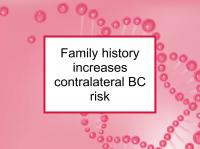Women who are diagnosed with breast cancer in one breast are at increased risk of subsequently developing breast cancer in the opposite (contralateral), or untreated, breast compared to the general population. The prognosis of women who develop contralateral breast cancer is relatively unfavorable.
Women with aggressive breast cancer subtypes (triple negative, HER2 positive, inflammatory breast cancer), as well as those with lobular breast cancer, are at heightened risk of contralateral breast cancer. A strong family history of breast cancer has been shown to increase the risk of contralateral breast cancer further in women with estrogen receptor negative (ER-) disease. Now a new study has reported that women under 45 with a family history of breast cancer have a heightened risk of contralateral breast cancer.
Asynchronous contralateral breast cancer
Asynchronous contralateral breast cancer is a breast tumor that occurs at some point after the original breast cancer diagnosis. When a new breast tumor is found, it is not always easy to determine whether this reflects a recurrence of the original cancer (occurring as a distant metastasis of that tumor) or a new primary breast tumor. Tumors that arise in the contralateral breast at least two years after the first cancer diagnosis are assumed to be new primary tumors.
Not surprisingly, the prognosis is worse for contralateral breast cancer occurring within two years of the original tumor. In fact, the development contralateral breast cancer has been found to be associated with a greater risk of dying from breast cancer throughout a long period of follow up.
Latest research finds risk is higher for young age with family history
The study referenced at the beginning of this news article was designed to evaluate the risk of contralateral breast cancer in breast cancer patients who have a family history of breast cancer, but do not have any BRCA1 or BRCA2 mutations. To conduct the study, the authors selected women enrolled in an existing study (the Women's Environmental Cancer and Radiation Epidemiology Study) who had tested negative for BRCA mutations. The present study included 594 patients with contralateral breast cancer and 1,119 patients with unilateral breast cancer (controls).
Family history of breast cancer was found to be associated with increased risk of contralateral breast cancer. The risk was relatively high among young women (under 45 years) who had first degree relatives (mother, sister, daughter) who were also diagnosed with breast cancer before age 45 (2.5 time higher than older women without a family history). The risk of contralateral breast cancer was highest among women with first degree relatives with bilateral disease, i.e., who were originally diagnosed in both breasts (3.6 times higher). In fact, these participants had risks of contralateral breast cancer similar to BRCA mutation carriers.
Women diagnosed with unilateral breast cancer under age 55 who had a first degree relative with contralateral breast cancer were found to have a 15.6% risk of contralateral breast cancer during the first 10 years after diagnosis. The authors conclude that the heightened risks of contralateral breast cancer described for some women in the study has important implications for the treatment of patients with breast cancer with family history of the disease.
Please see our article on familial breast cancer for more information.
